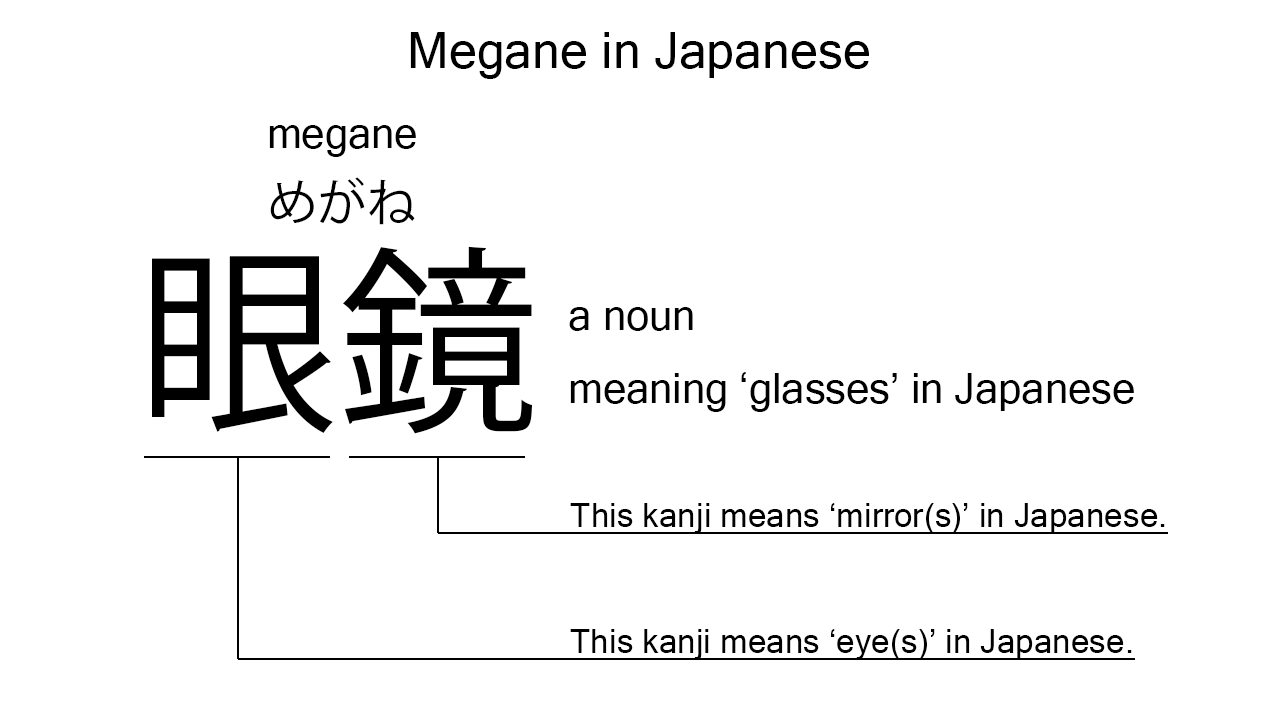What does “megane” mean in Japanese?
Native speakers say “megane” to mean ‘glasses’ in Japanese. Perhaps, some Japanese learners know this word as it is sometimes used in Japanese conversations. In this blog post, however, I will explain this word in detail based on its kanji expression. And also, I will explain how to use it through example sentences. My explanations would help Japanese learners understand “megane” more clearly. Then, let’s get started!
Contents
Definition and meanings of “megane”
Let me start with the definition and meanings of “megane”.
- megane – 眼鏡 (めがね) : a noun meaning ‘glasses’ or more specifically ‘a pair of glasses’ in Japanese.
Native speakers often use this noun as singular to refer to a pair of glasses in Japanese. This focuses more on the pair itself rather than its parts.
The definition and meanings are not that difficult, I think. To understand this noun more clearly, however, let me explain its kanji characters in detail, one by one.
What does “megane” literally mean in Japanese?
The kanji expression of “megane” consists of the following two kanji characters:
- 眼 : a kanji character used to mean ‘eye’ in Japanese.
- 鏡 : a kanji character used to mean ‘mirror’ in Japanese.
These two parts tell us that “megane” literally means ‘eye mirrors’ in Japanese. This literal interpretation is not completely in line with the actual meanings, but still understandable, I think. Glasses work for eyes and utilize the refraction of light like mirrors.

When we meet new kanji expressions, we should check their characters in detail to understand their meanings clearly and deeply. In many cases, kanji characters tell us a lot about the meanings of the expressions they form. Actually, here, we could get the better understanding of “megane” through the detailed kanji check above.
So far, I’ve explained the definition and meanings of “megane” together with its kanji characters. Then, let me explain how to use it through the example sentences below.
Example #1: how to say “glasses” in Japanese
kare wa kyou atarashii megane wo kat ta – 彼は今日新しい眼鏡を買った (かれはきょうあたらしいめがねをかった)
He bought a new pair of glasses today.
Below are the new words used in the example sentence.
- kare – 彼 (かれ) : a pronoun meaning ‘he’ in Japanese.
- wa – は : a binding particle working as a case marker or topic marker. In the example, this works after “kare” to make the subject in the sentence.
- kyou – 今日 (きょう) : a noun meaning ‘today’ in Japanese. This can also work as an adverb almost anywhere in a sentence. In the example, this works as an adverb to say “today” in Japanese.
- atarashii – 新しい (あたらしい) : an i-adjective meaning ‘new’ in Japanese. In the example, this works in front of “megane” to say “a new pair of glasses” in Japanese.
- wo – を : a case particle used to make the object word in a sentence. In the example, this is used after “atarashii megane” to make the object in the sentence.
- kat – 買っ (かっ) : one conjugation of the verb, “kau“, which means ‘to buy’ or ‘to purchase’ in Japanese. In the example, it has been conjugated for the better connection with its following word.
- ta – た : an auxiliary verb used after a verb, adjective, or auxiliary verb to make its past tense form. In the example, this is used after “kat” to make its past tense form, “kat ta”.
This is a typical usage of “megane”. In the example, it works as a part of the noun phrase, “atarashii megane”, which means ‘a new pair of glasses’ in Japanese.
Example #2: another usage of “megane”
kanojo wa kare no megane wo kake te iru – 彼女は彼の眼鏡をかけている (かのじょはかれのめがねをかけている)
She is wearing his glasses.
Below are the new words used in the example sentence.
- kanojo – 彼女 (かのじょ) : a pronoun meaning ‘she’ in Japanese.
- no – の : a case particle used after a noun or pronoun to make its possessive case. In the example, this is used after “kare” to make its possessive case, “kare no”, which means ‘his’ in Japanese.
- kake – かけ : one conjugation of the verb, “kakeru”, which means ‘to hang’ in Japanese. In the example, it has been conjugated for the better connection with its following word.
- te – て : a conjunctive particle used after a verb, adjective, or auxiliary verb to make its te form. In the example, this is used after “kake” to make its te form, “kake te”. Verbs need to be changed to their te forms to be connected with “iru”.
- iru – いる : an auxiliary verb used to express the continuity of the action described by its preceding verb. In the example, this is used after “kake te” to express the continuity of its action, ‘to hang’.
This is another typical usage of “megane”. In this example, it works as a part of the widely-used phrase, “megane wo kake te iru”, which literally means ‘to be hanging glasses’ in Japanese. This phrase is often translated into English as ‘to be wearing glasses’, though.
Summary
In this blog post, I’ve explained the definition and meanings of “megane” in detail based on its kanji expression. And also, I’ve explained how to use it through the example sentences. Let me summarize them as follows.
- megane – 眼鏡 (めがね) : a noun meaning ‘glasses’ or more specifically ‘a pair of glasses’ in Japanese. Japanese native speakers often use this noun as singular because this focuses more on the pair itself rather than its parts. These two kanji characters literally mean ‘eye mirrors’ in Japanese. This literal interpretation is not completely in line with the actual meanings, but still understandable, I think. Glasses work for eyes and utilize the refraction of light like mirrors.
Hope my explanations are understandable and helpful for Japanese learners.